We’re all familiar with at least a few different types of trees. But did you know that there are over 60,000 types of trees? These majestic plants are found all over the world. In fact, they grow on every continent except Antarctica.
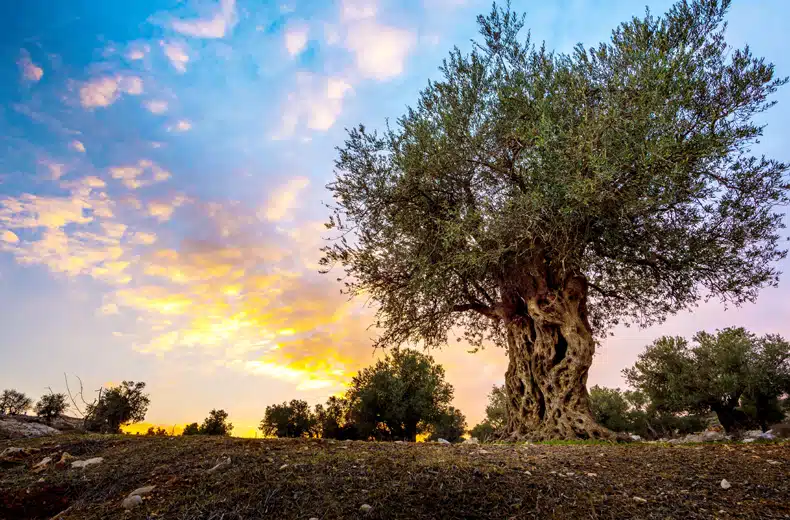
I’ll walk you through 50+ tree names and pictures in this guide. So, you can browse through and become an expert on some of the most common tree types.
Or you can use this article as a way to identify a specific tree. You’ll soon become an expert on all the different types of trees in your neighborhood and further afield.
I’ll share all sorts of trees, from tropical trees names to mountain trees names. You’ll find that different varieties grow depending on the ecosystem. So, if you’ve ever wondered about tree types and their meanings, read on.
50 Popular Types of trees
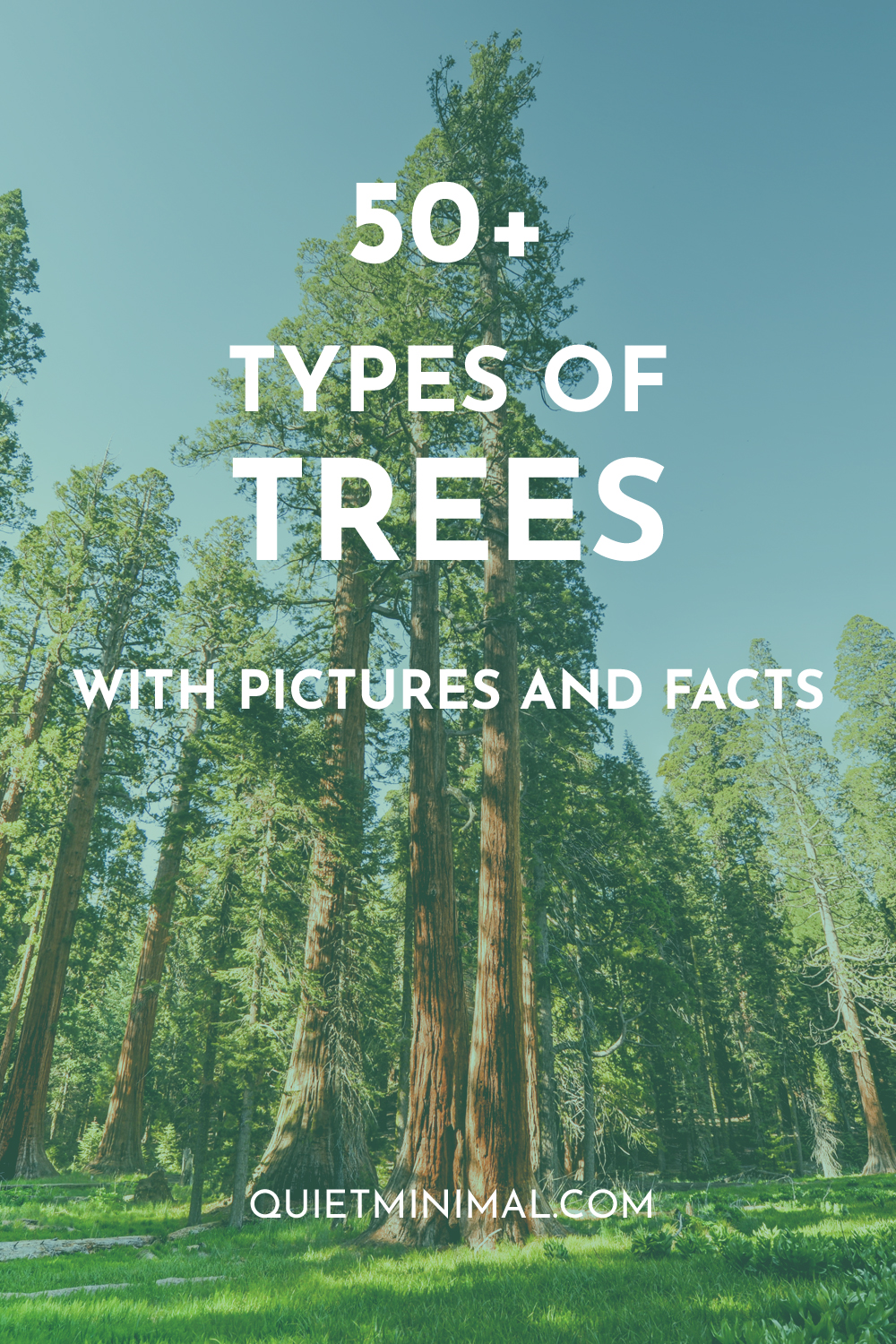
1. Oak Trees
Oak trees are beautiful trees that grow to massive sizes if given a chance. But the process happens very slowly over hundreds of years. From a tiny acorn to a mighty oak, as the saying goes.
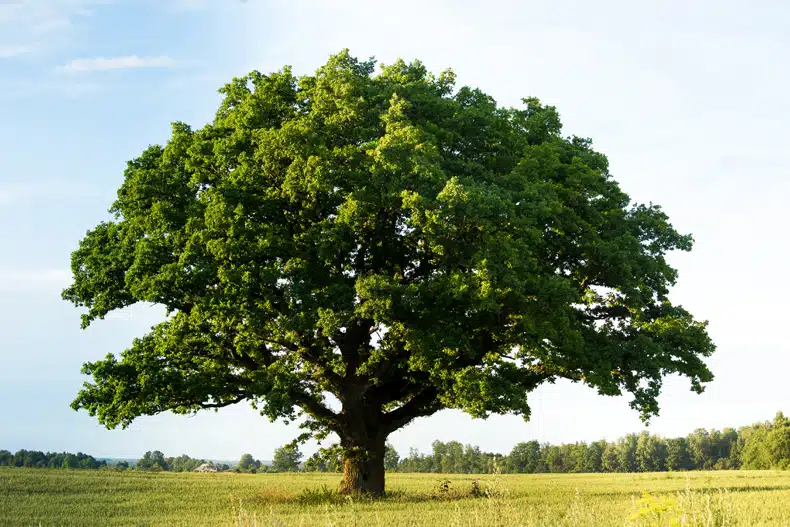
These trees are prized for their durable and valuable hardwood. In the past, it was a popular choice for furniture, wood paneling, and even building ships.
There are two main types of oaks, white oaks, and red oaks. As their name suggests, red oaks have darker bark than white oaks. But each type produces acorns, which you may find scattered over the ground near an oak tree.
2. Birch Trees
Birch trees are hardwood deciduous trees that are easy to spot. They have a silvery bark, although it can look white depending on the tree. The leaves are triangular, have a serrated edge, and droop downward.
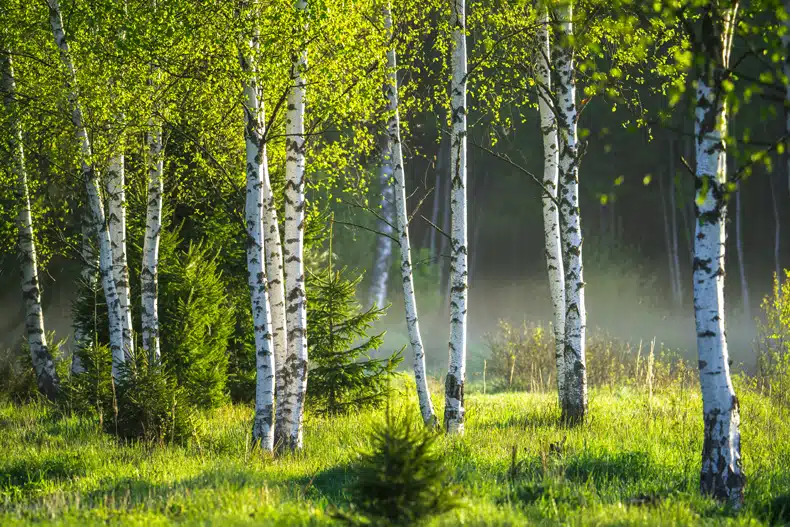
There are eleven common types of birch trees such as the bog birch, cherry birch, and paper bark birch. There are also local varieties, including the Himalayan and the Japanese white birch.
They grow worldwide in temperate zones and look very pretty, especially in winter. During the colder seasons, it’s easier to notice the silvery look of their trunks.
3. Ash Trees
Ash trees have dense leaves that grow in a well-rounded crown, starting fairly low down. These trees often have a greyish bark and are very strong and dense. They can withstand all sorts of weather conditions and live for centuries.
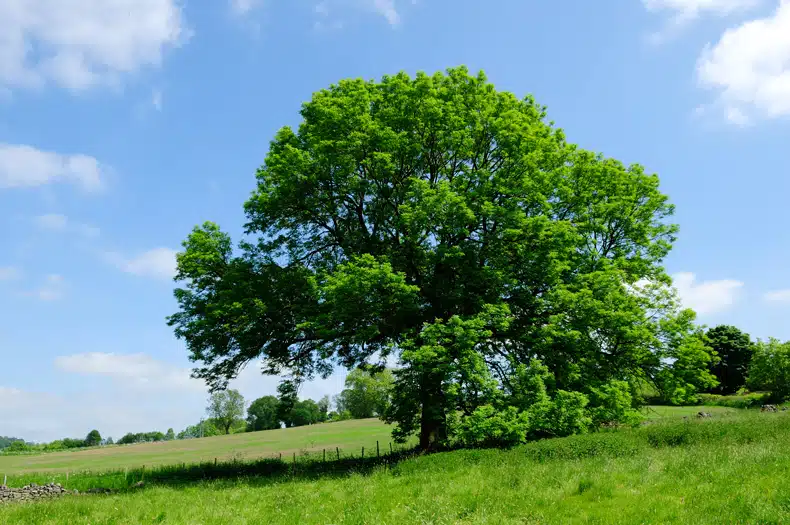
Many ash trees grow up to around 60 or 70 feet tall. So, they’re not the tallest trees in the woods but still become a respectable size.
There are various types of ash trees, including the almost-extinct black ash tree. The wood of this tree is favored for making guitars. But unfortunately, it’s been badly affected by an invasive bug species. And as a result, its numbers are dwindling.
4. Sycamore Trees
Sycamore trees are mighty hardwood trees that grow a huge trunk and a large, leafy crown. You’ll find that the trunk is covered with thinner, reddish bark.
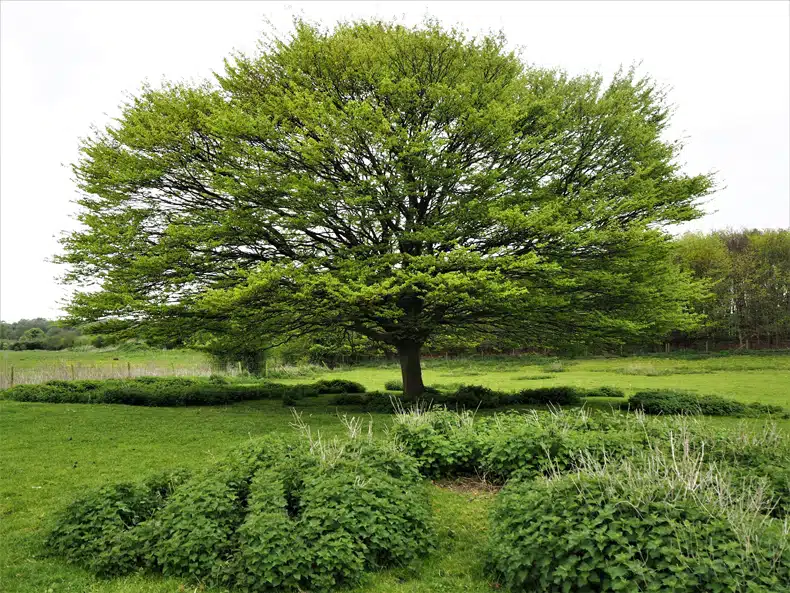
They are popular choices in parks and gardens as they provide a lot of shade. Beneath a sycamore tree is an ideal place to have a picnic! Sycamores grow across Europe, North America, and certain parts of western Asia.
5. Maple Trees
Maple trees are easy to identify, thanks to their distinctive bright red leaves. These leaves also have a unique shape that you’ll recognize from the Canadian flag.
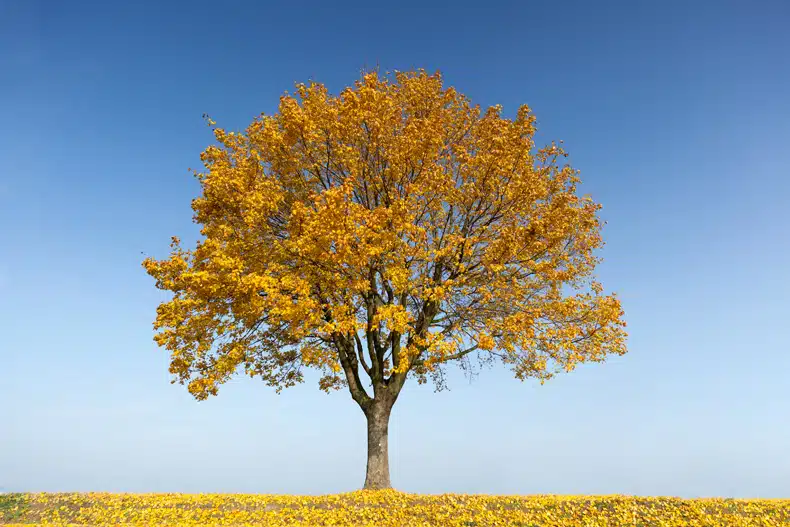
Maples are the national tree of Canada, but they grow much more widely than you might imagine. You can find them all across North America, but also in China and Japan. Maples are native to many other northern countries, too.
The sugar maple tree is perhaps the most famous type of maple. It produces that world-famous sweet maple syrup that tastes so good on pancakes. But even the varieties that don’t make sweet syrup look bright and beautiful.
6. Cedar Trees
These gorgeous trees are tall evergreens with needles and quite sparse trunks. The branches spiral up from the tree and give off a piney scent. You can find cedar trees in many countries, but they originated in the Mediterranean.
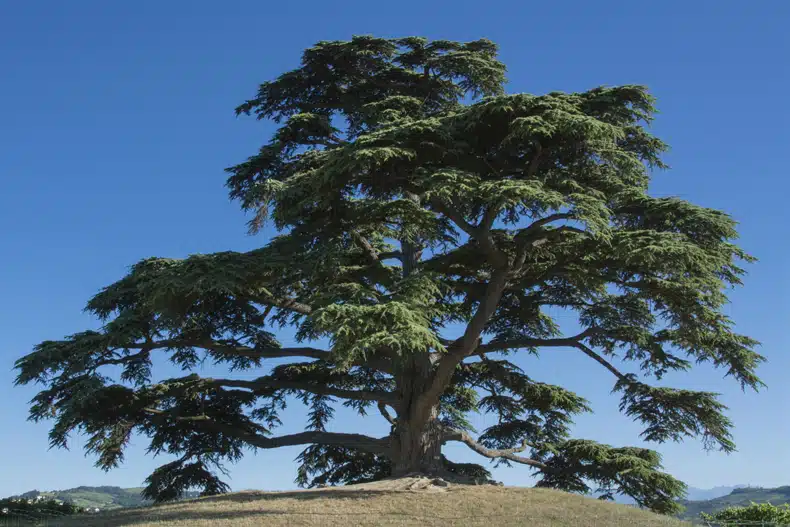
Cedars are hardwood trees that grow to great heights of 150+ feet. They look elegant, making them popular in parks and gardens as ornamental trees. And at the opposite end of the scale, you can also find tiny bonsai cedars. There are many varieties of cedar trees, including:
- The Atlantic White Cedar
- The Northern White Cedar
- The Western Red Cedar
- The Atlas Cedar
7. Juniper Trees
Junipers are often mistaken for cedar trees. But they are a different species of trees altogether. The difference is that a juniper tree is an evergreen tree rather than a deciduous one.
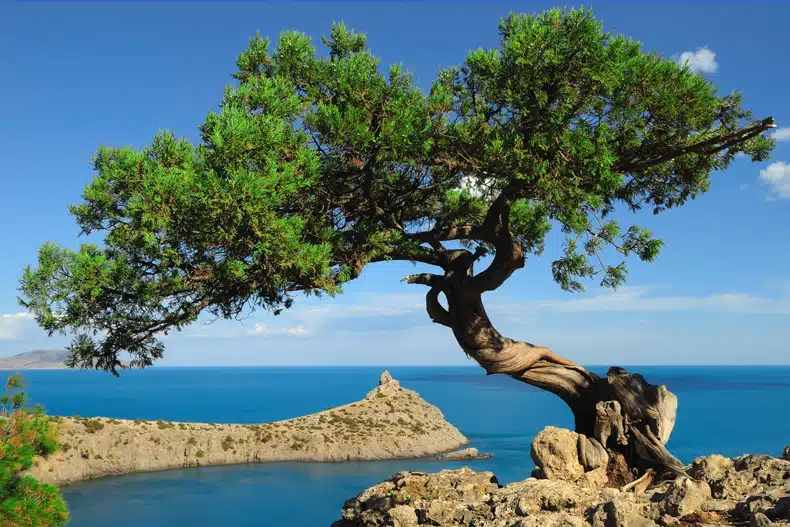
As small trees, junipers usually have spiky needles and dense little cones with a strong piney scent. But as they mature, these needles fan out into scaly leaves with clusters of needles.
While junipers can grow up to 100 feet tall, many stop at around 6 feet. So, you’ve probably seen more of the smaller, shrubby junipers than tall, elegant ones.
8. Willow Trees
When you think of a willow tree, you can probably picture this distinctive tree in your head. It’s easily identified by its low-hanging branches and oval leaves. These trees are often found near water, such as lakes, rivers, or streams.
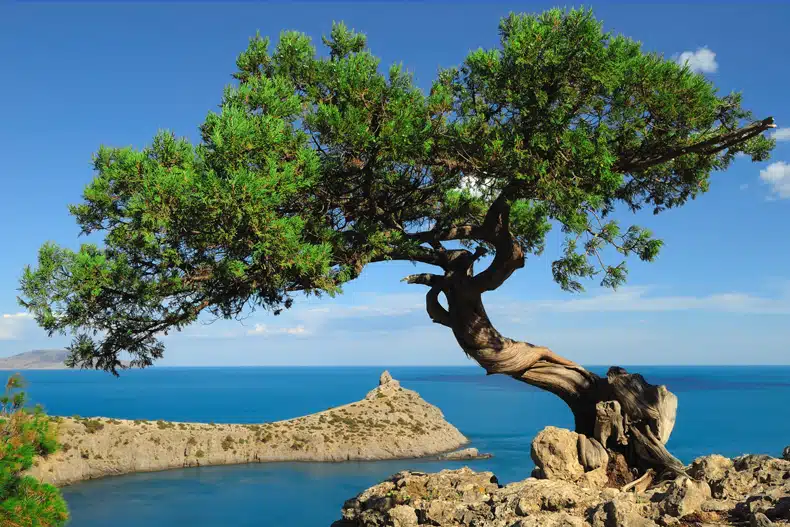
As they’re deciduous trees, they lose their leaves in the winter. And in fact, there are many different types of willow trees, with over 400 in total. These include dwarf willows, smaller shrubs, and giant trees that tower above us.
9. Hickory Trees
Hickory trees grow across China, India, and much of North America. In these countries, they are popular as they produce edible nuts. They are related to walnut trees, and the pecan tree is also from the hickory tree family.
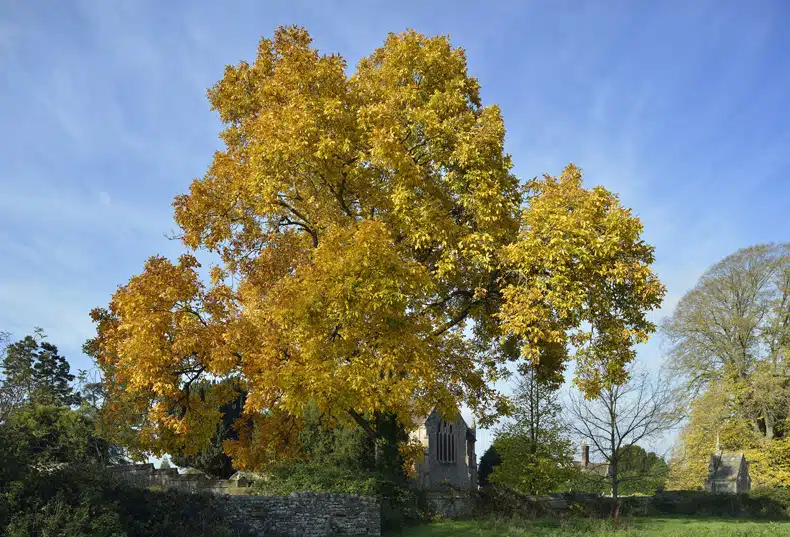
You can identify a hickory tree by looking at the nuts and leaves. Hickory leaves are large and end at a point, while the nuts have thick shells. This hardwood variety is useful for making baseball bats and hockey sticks.
10. Apple Trees
Apple trees are found worldwide and are easy to spot due to their bountiful fruit. There are many different varieties of apple trees (over seven thousand in total). These trees have been cultivated for their fruit for centuries, if not millennia.
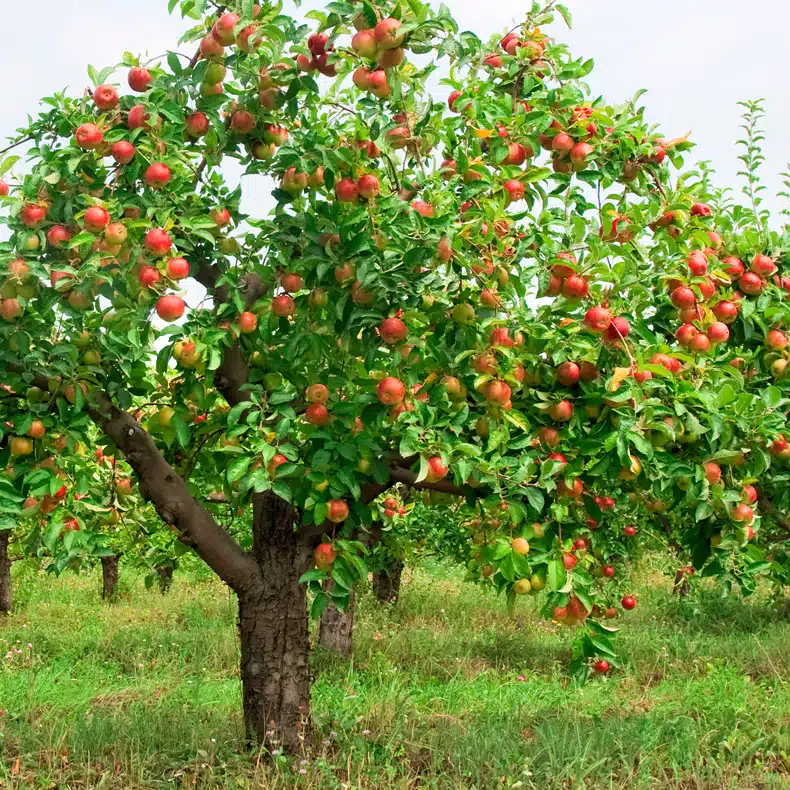
They aren’t the tallest trees, growing to around forty feet or slightly less. The branches spread widely and are covered in beautiful blossoms during the spring. Then, in late summer and autumn, you’ll see the crop of apples.
11. Crabapple Trees
It’s easy to get confused between apple trees and crabapples. The second is a smaller variety of apple trees that often appear quite shrubby. They don’t get as big and are excellent additions to a garden or city park.
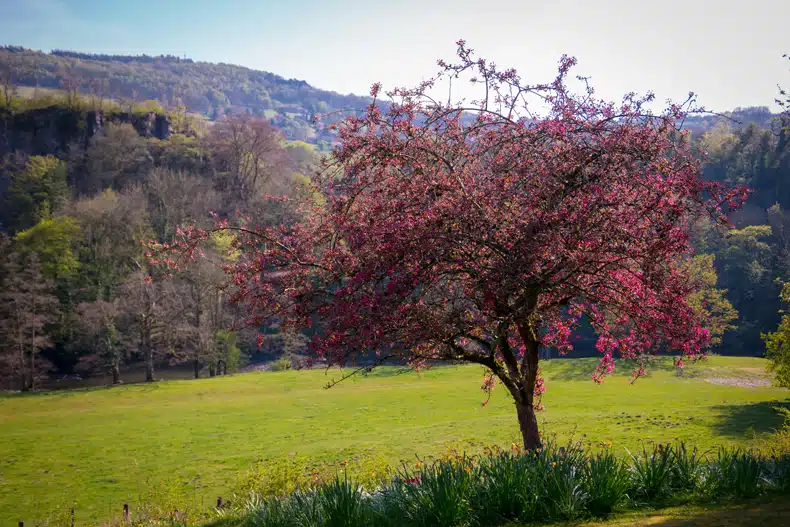
Brightly colored pink, orange, or purple blossoms bloom in abundance during the spring. And later in the year, they grow crabapples. Although these fruits are pretty sour, they’re safe to eat. But due to their sharp taste, they’re not as popular as regular apples.
12. Pear Trees
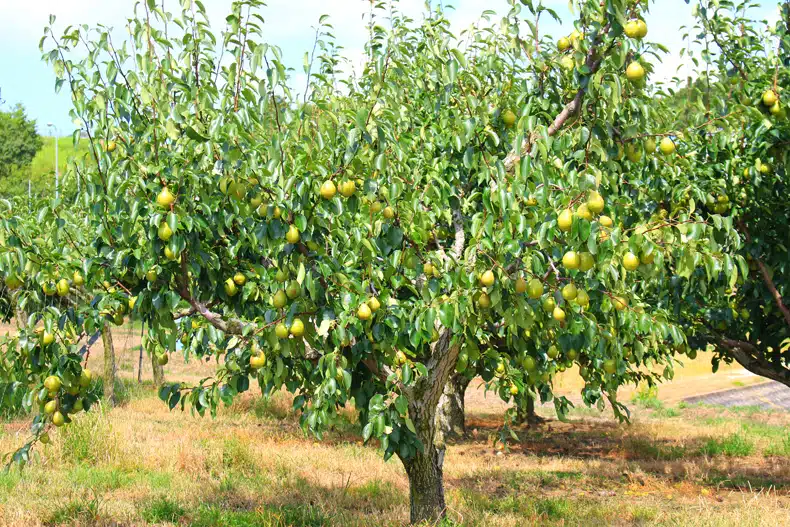
Pear trees are another fruit tree popular for their delicate white flowers. Thanks to its rich, autumnal shades, it also looks beautiful in the fall. Most pear trees bear juicy, tasty fruit. But some ornamental varieties are too small and can taste bitter.
13. Cherry Trees
Cherry trees also grow all over the world, from North America to Europe and Asia. They’re quite a sensation during the spring when people travel to see the amazing blossoms. Japan and Amsterdam are popular destinations to see cherry trees. They bloom with pink or white flowers that draw locals and tourists alike.
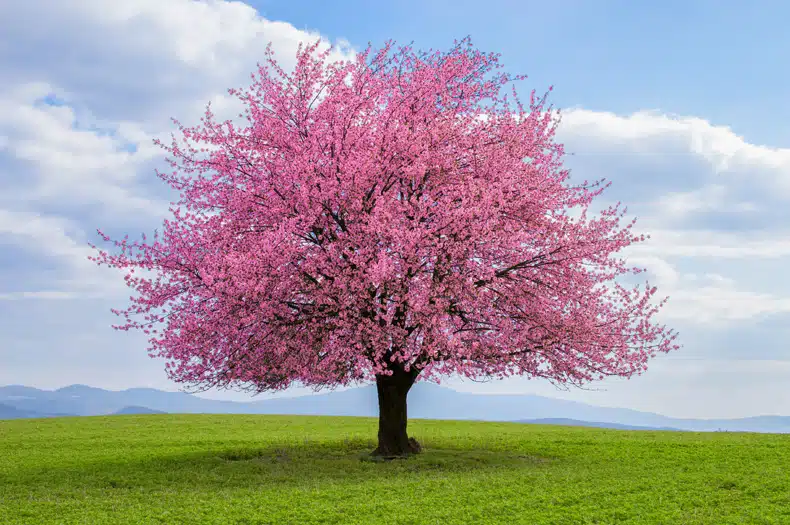
There are hundreds of varieties of cherry trees. These include the black cherry tree, pin cherry tree, sweet cherry tree, and sour cherry tree, to name a few.
Cherry trees tend to be medium in size and grow quickly. The wood can be used for furniture and is highly sought after and quite expensive.
14. Peach Trees
While we’re discussing fruit trees, we shouldn’t forget the peach tree. This tree is native to northwest China but has been exported worldwide. Now, you can find peach trees all over, but they grow best in temperature regions. They are of the same family as other stone fruit, such as the plum, apricot, and cherry trees.
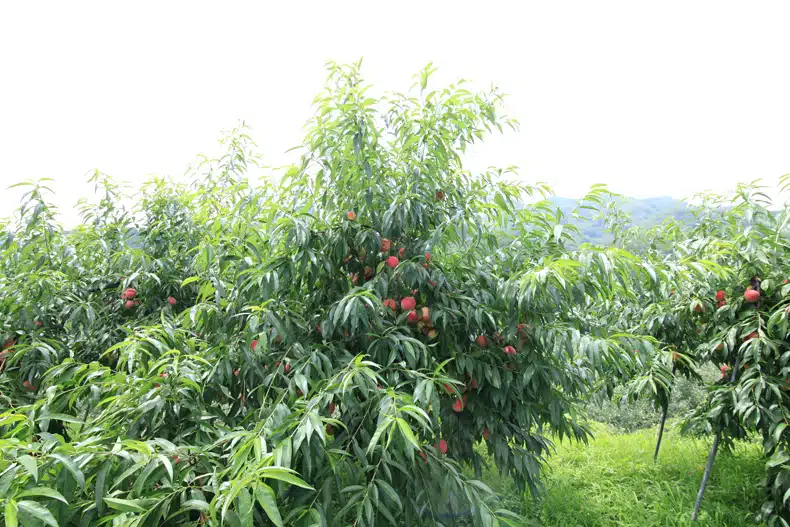
Peach trees don’t grow to be very tall, reaching about 20 feet at their largest. They are best known for their pretty flowers and, of course, the juicy peaches in the late summer.
15. Fig Trees
The fig tree is a smaller variety native to western Asia and the Mediterranean. Humans have cultivated this tree for its fruit for thousands of years. And now, it grows almost all over the globe.
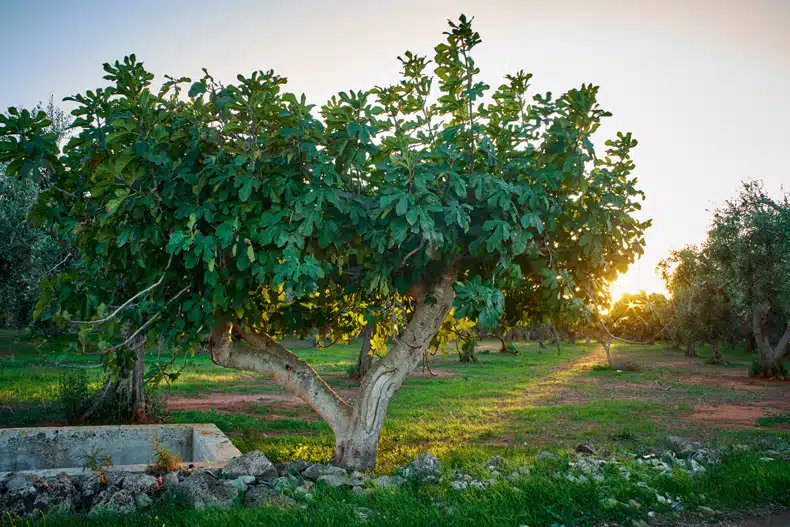
Notable features of this tree are its smooth white bark and fruit in the summer months. It tends to reach around 30 feet at its tallest and is a relatively hardy tree. But it will grow best when it gets warm temperatures and plenty of sunlight.
16. Banyan Trees
The banyan tree is perhaps less well known because it grows in much of Asia. But it can also be found growing naturally in Central and South America.
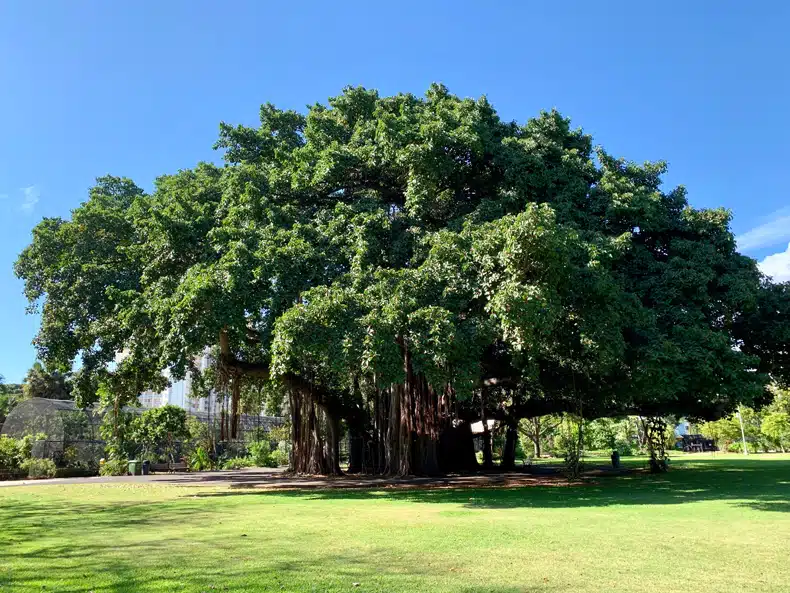
This tree is unique because it starts growing from another plant. First, the seed will fall into a crevice of a tree or land on another plant. Then, the banyan tree will live off of this plant until it eventually takes it over and kills it off. And that’s where the banyan tree gets the name ‘strangler fig.’
Banyan tree roots extend far around the tree instead of deep below the surface. These trees are best suited to wet soils in tropical climates. And you might not guess it, but they’re actually related to the fig tree.
17. Neem Trees
The neem tree is another exotic tree that grows in tropical areas of Asia. In particular, it’s found in Cambodia, Laos, India, and Thailand, among other countries.
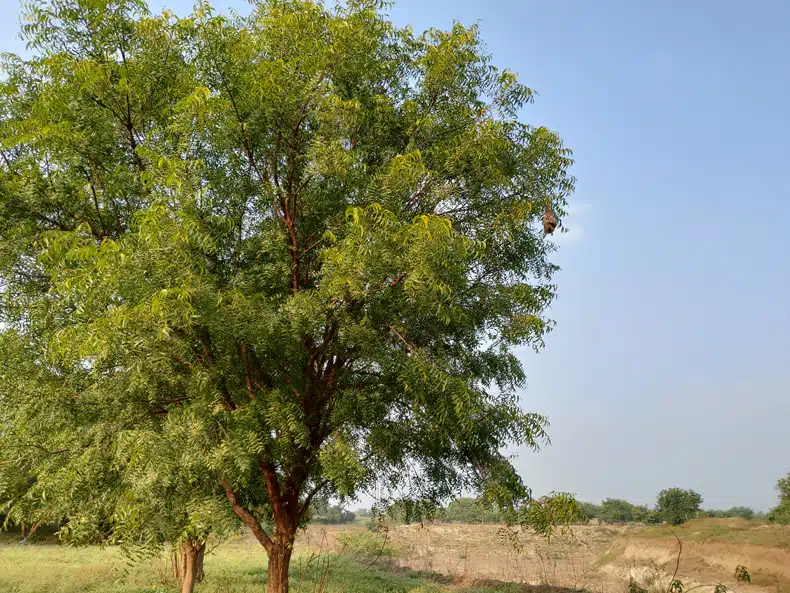
It grows best in countries with plenty of rain and a warm temperature all year round. It won’t survive anywhere the temperature falls too low.
The neem tree is a fast grower and can reach up to 130 feet in height. It has wide branches and blooms with a vast quantity of white flowers in the springtime. But it’s considered a weed in some places as it can be pretty invasive.
18. Mahogany Trees
Mahogany trees have long been famous for their high-quality wood. These trees grow in Florida, the USA, and many Caribbean islands. It’s best suited to tropical regions with plenty of rain and sunlight.
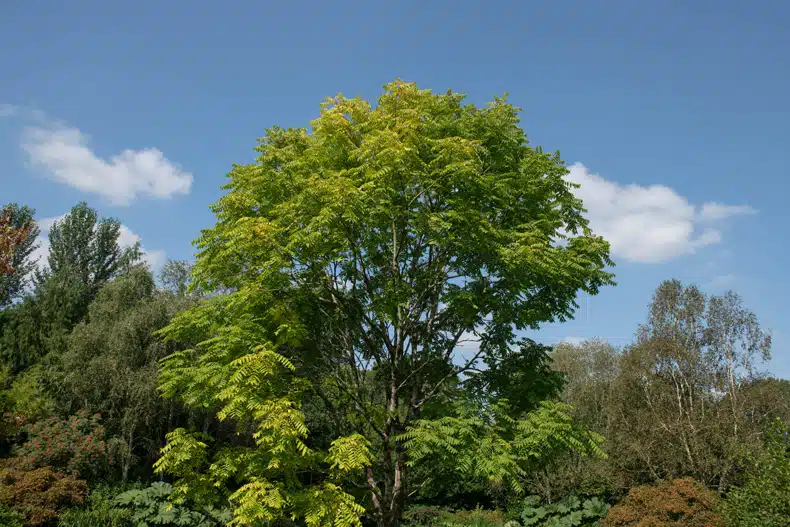
These medium-sized trees can reach around 80 feet in height and have rich, dark trunks. Mahogany leaves are first red but turn green as they grow. Unfortunately, mahogany trees have been cultivated for their wood, leading to large-scale deforestation. But protections are now in place to protect this majestic tree.
19. Teak Trees
The teak tree is prized for its durable, weather-resistant wood. It’s often used to make furniture, boats, and flooring.
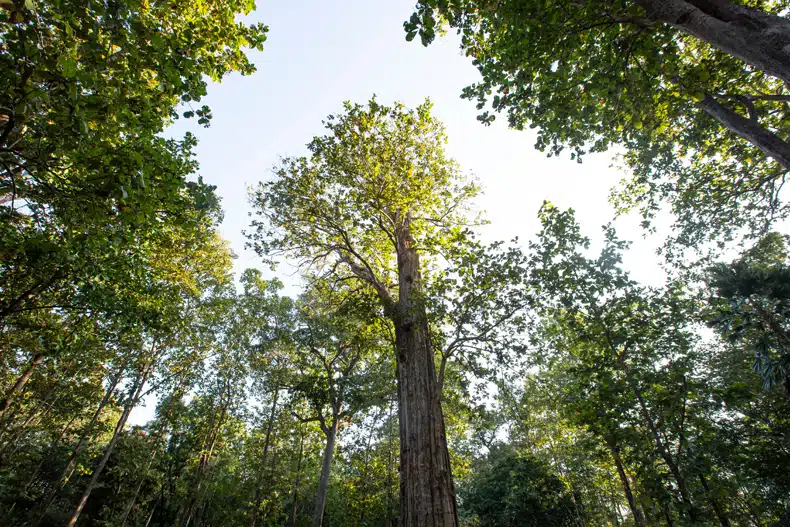
This tree grows to lofty heights of 130+ feet and has few branches along the trunk. There are more branches near the top of the trunk, making a small crown. The teak tree leaves are large but thin, with a smooth rather than serrated edge.
20. Walnut Trees
The walnut is another deciduous tree that grows to a large size. It has a large crown and rough bark that may look gray, light brown, or dark brown. The leaves grow alternately along the stem, and it also grows large walnuts in their shells. If you have a walnut tree nearby, you can collect them and eat them as a nutritious snack.
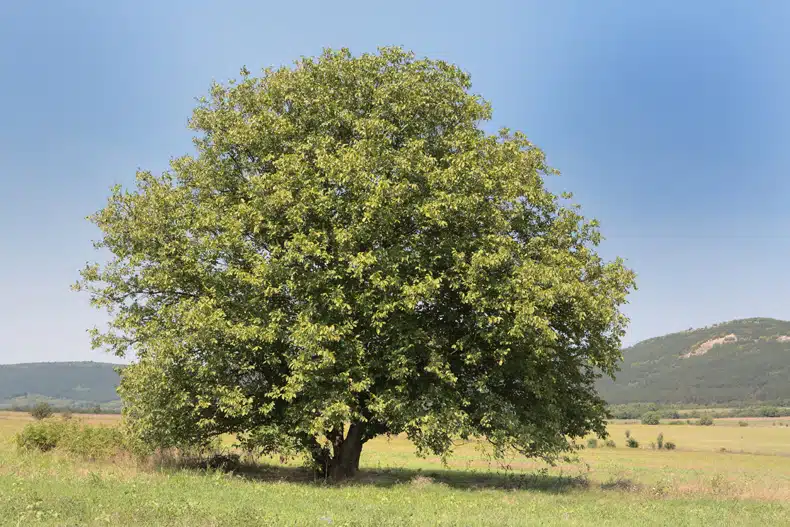
This robust and durable wood can also be used for all sorts of things. In particular, the wood of the black walnut tree is sought after.
21. Elm Trees
You’ll often find elm trees in forests or parks. They’re a great place to sit as they provide plenty of shade. And their low-hanging branches are tempting to climb on.
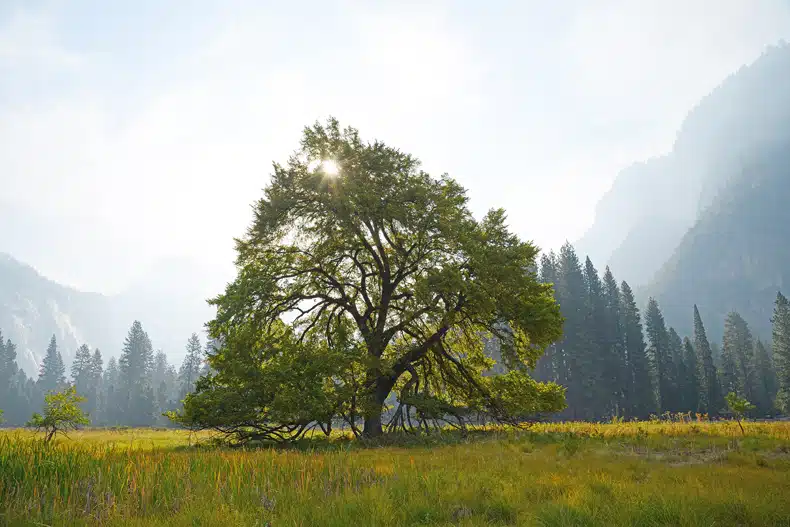
There are many varieties of elms, including the American elm, English elm, and the slippery elm.
Unfortunately, the Dutch Elm disease has affected many of these trees. But the ones that are still around are beautiful.
You may have heard of slippery elm bark used for traditional medicine. The indigenous people of North America first used it, and it’s still a popular alternative remedy.
22. Hawthorn Trees
The hawthorn tree grows across much of Asia, Europe, and North America. There are many different types and some great myths and tales linked to this tree. In some cultures, it’s seen as a fertility symbol.
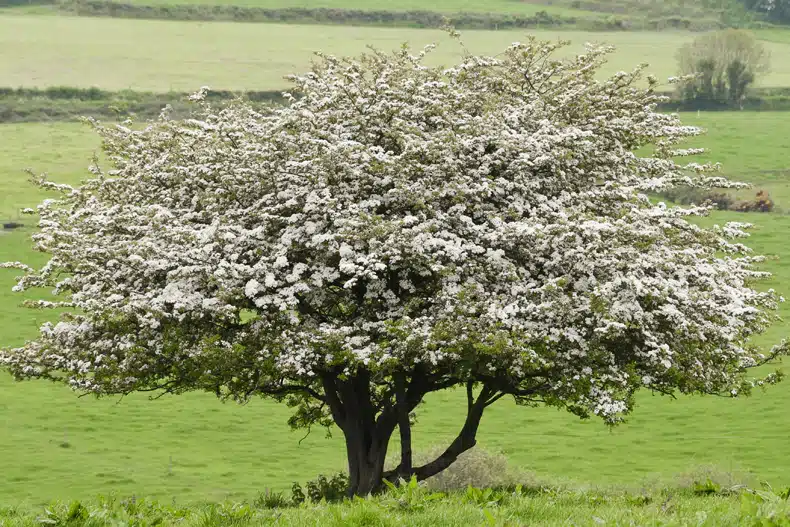
Hawthorn trees are related to apple trees. They look pretty and delicate and don’t grow to great heights. So, they make nice ornamental trees along streets or in gardens. These trees produce edible fruits and strong-smelling flowers. These are the best way to identify a hawthorn tree.
23. Spruce Trees
Spruce trees are evergreens that grow widely across the northern USA and Canada. But originally, they came from the boreal regions of northern Europe. These trees can survive even the coldest temperatures and grow up to 200 feet.
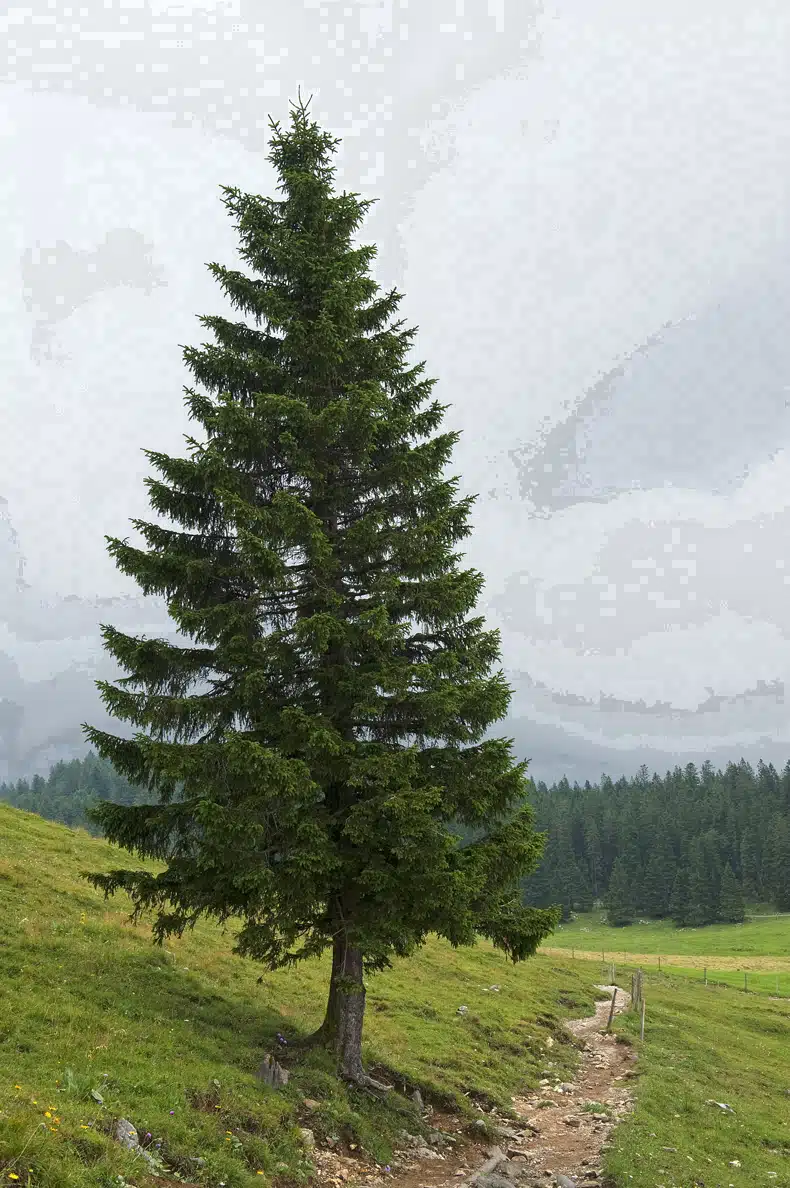
There are many types of spruce trees, but all have prickly pine needs. They are commonly used as Christmas trees and also for lumber.
24. Fir Trees
Fir trees grow in cooler regions in the north of Europe, Asia, and North America. They thrive in cool, mountainous areas with loose, fertile soils. These hardy trees can survive in the coldest of temperatures. And of course, these trees are evergreens, so they don’t lose their leaves in the winter.
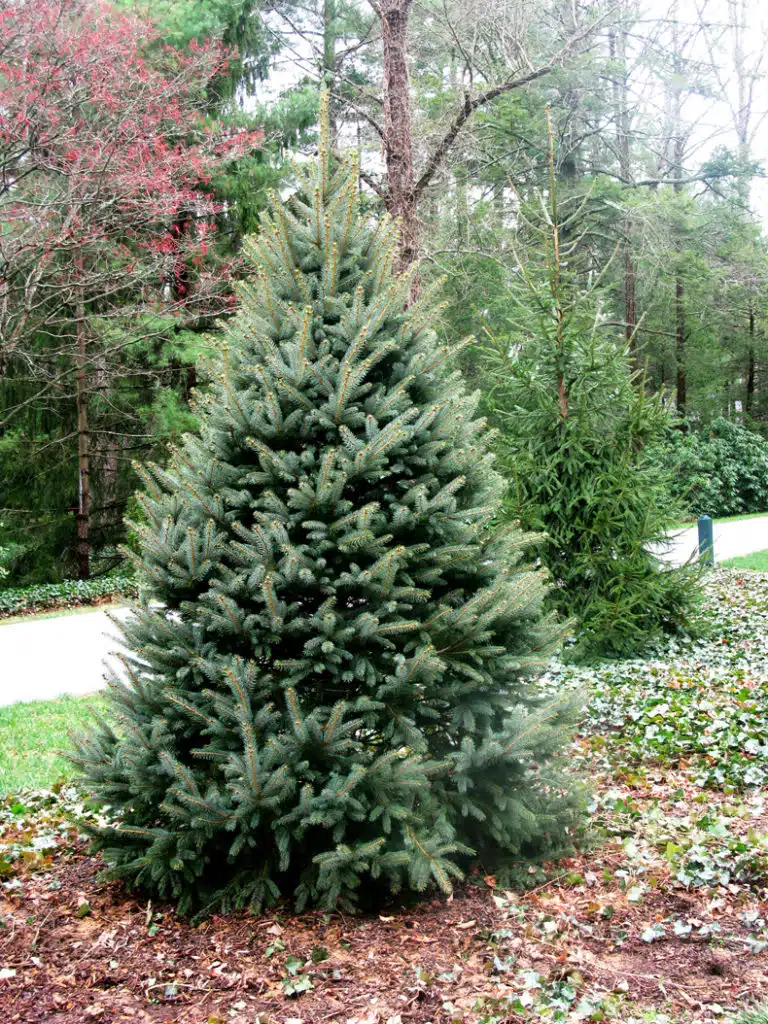
When you picture a Christmas tree, it’s probably a fir tree that comes to find. They have smooth, gray bark and soft, fragrant needles. There are many types of fir trees, including the balsam fir, Douglas fir, and balsam fir.
25. Beech Trees
In contrast with fir trees, the beech is a beautiful big leafy tree of the deciduous variety. These trees have a well-rounded crown of leaves, providing lots of shade. They look particularly eye-catching as the leaves change color in the fall.
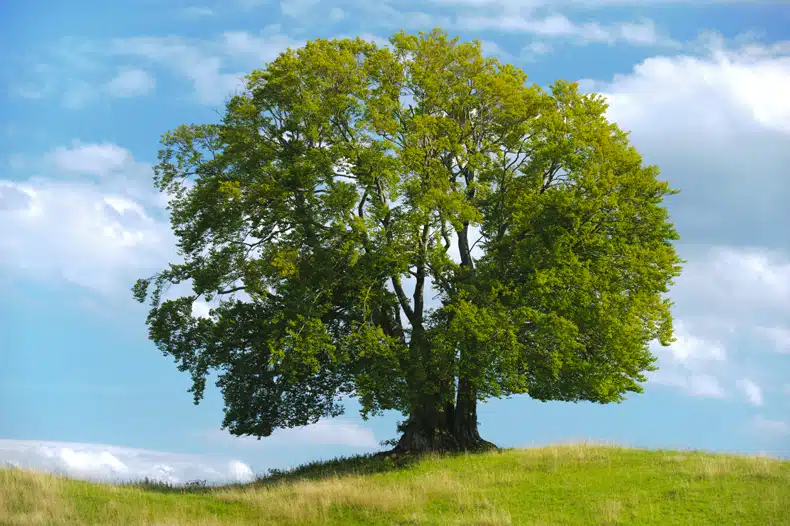
Beech trees produce flowers called catkins as well as a fruit called beechnuts. While these nuts are edible, they taste very bitter and aren’t commonly eaten. There is a North American beech tree variety and a European beech tree species.
26. Cucumber Tree
One of the rarer trees, the cucumber tree grows in certain areas of the USA and Canada. It can mainly be found in Ontario and along the east coast. It gets its name from the unusual bright green fruit that looks like a large, fat cucumber.
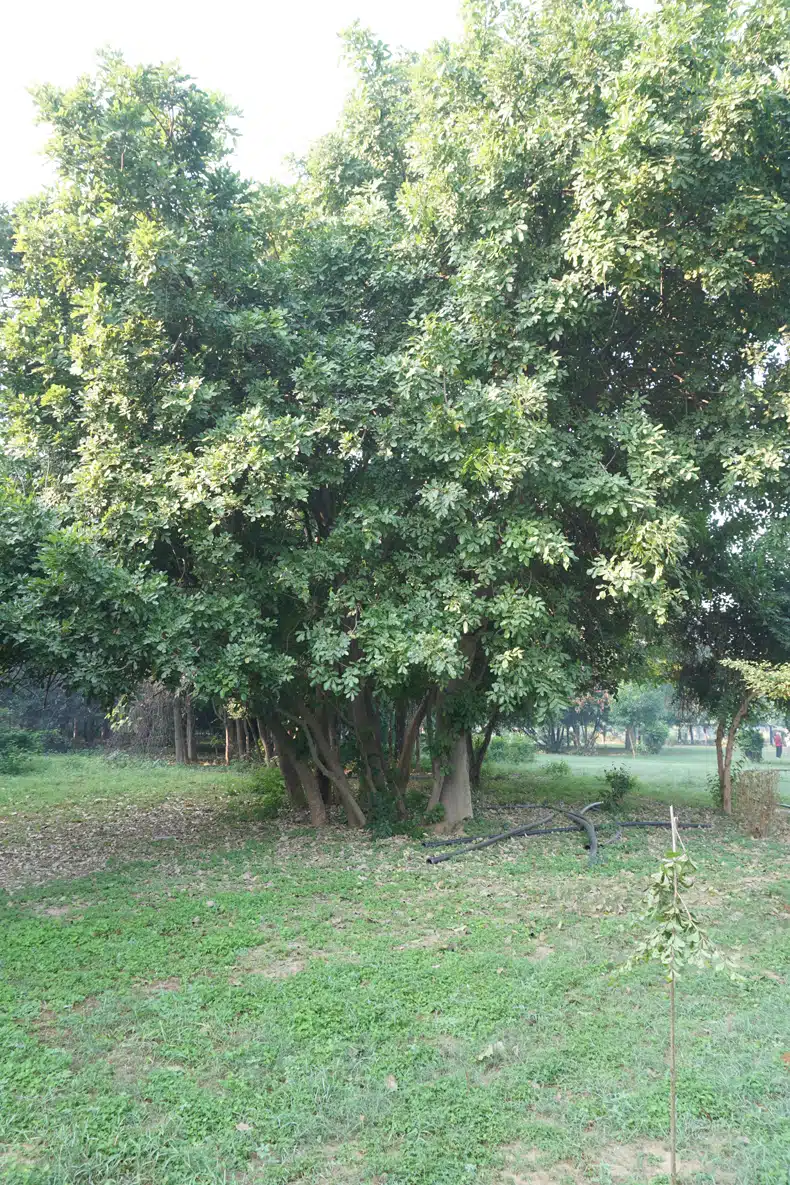
The cucumber tree grows best in moist soil in wooded areas or low hills. If you cut a twig from this tree, it emits a lovely scent. These trees are sometimes used as ornamental trees. But although it has delicate flowers, they grow high up and are tricky to see.
27. Cottonwood Trees
Cottonwood trees are easily recognizable in the summer. That’s because they grow seeds covered in a soft, cottony covering.
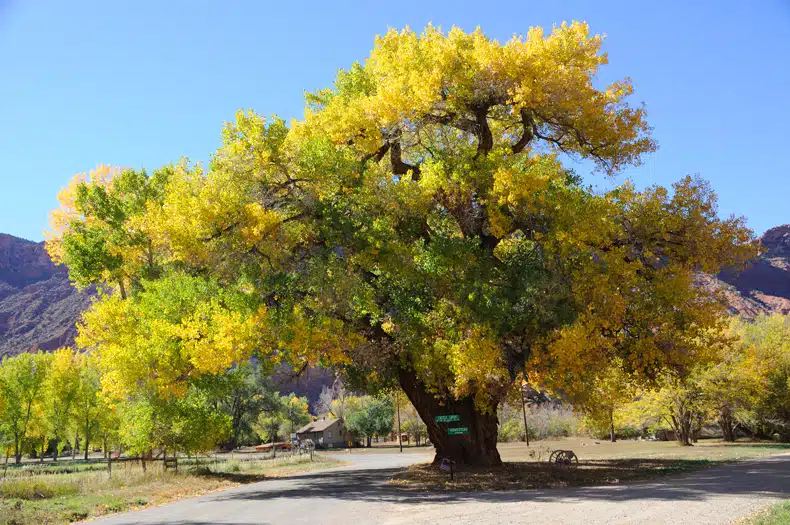
This distinctive tree gets its name from these strange, fluffy seeds. Unfortunately, some people are allergic to these seeds, and the fluff can make a lot of mess, too.
A cottonwood tree can grow up to 80 feet, although many only reach around 50 feet. A notable feature is the large, heart-shaped leaves that taper to a point.
28. Cypress Trees
A tree originating from the Mediterranean region, the cypress is an evergreen. It produces acorn-like cones and doesn’t lose its leaves in the winter. The cypress leaves are soft and pointy, like a cross between needles and regular leaves.
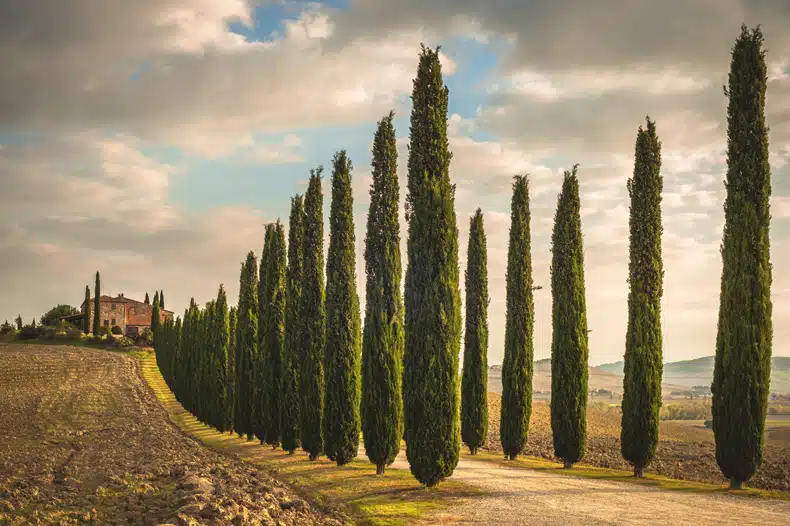
Confusingly, there are true and false cypress trees. The true cypress varieties are the Mediterranean and the Monterey cypresses.
But others are actually from a different family of trees and are ‘fake’ cypresses. These include the Pond, Hinoki, Lawson, and bald cypress.
29. Eucalyptus Trees
The eucalyptus is a distinctive tree, thanks to its scented leaves. Eucalyptus oil is often used in alternative medicine for coughs and other ailments.
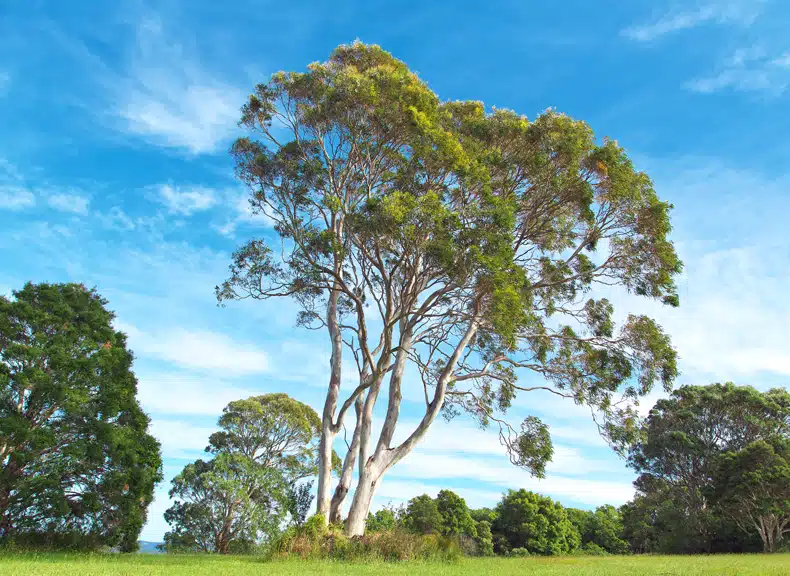
Eucalyptus bark is notable for its smooth appearance, although it can also look like it’s peeling. The tree produces flowers that can vary in color, and it can grow anywhere from 30 to 300 feet tall.
These trees are native to Australia, but they’ve been exported all over the world. They grow well in temperature and tropical areas rather than cooler or dry climates.
30. Magnolia Trees
The magnolia tree is well-known for its beautiful flowers. And as there are more than 100 varieties, they bloom throughout the year. The earliest magnolias flower in late March, but others will bloom much later in the year.
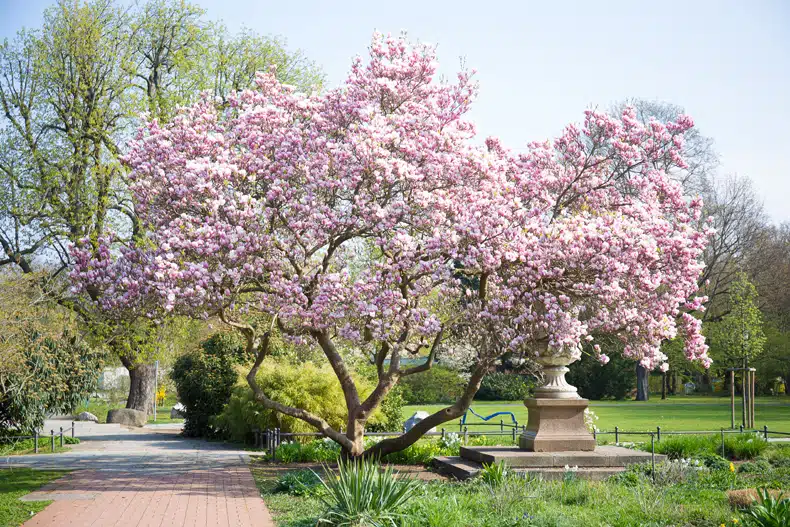
A few common types include pink magnolia and lily magnolia. Others are named after the areas where they thrive. For example, the southern magnolia and the mountain magnolia.
The leaves of the magnolia tree are thick, hardy, and feel quite rubbery. The magnolia fares best when it gets some sunlight every day, but it can cope with many soil types.
31. Dogwood Trees
Dogwood trees are common ornamental trees with beautiful white or yellow flowers. They grow across the eastern side of the USA and in northern Mexico. They need plenty of rainfall and sunlight to thrive.
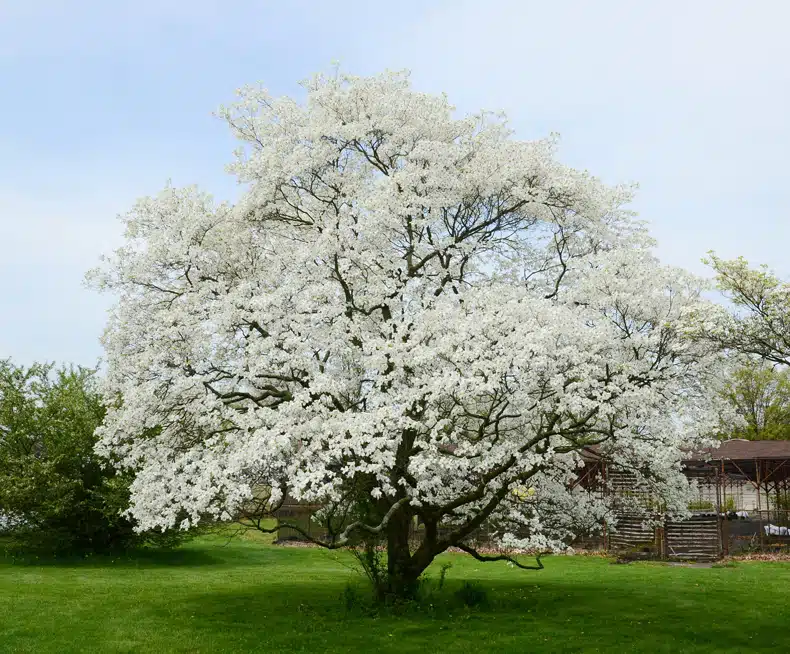
The memorable name comes from the fact that dogwood bark could cure dogs of mange. And while the wood has been used for timber, it’s not commonly used nowadays.
32. Poplar Trees
Poplars are fast-growing trees native to large swathes of the globe. They grow naturally in Europe, Asia, Africa, and North America. As they’re deciduous trees, they lose their leaves in the winter.
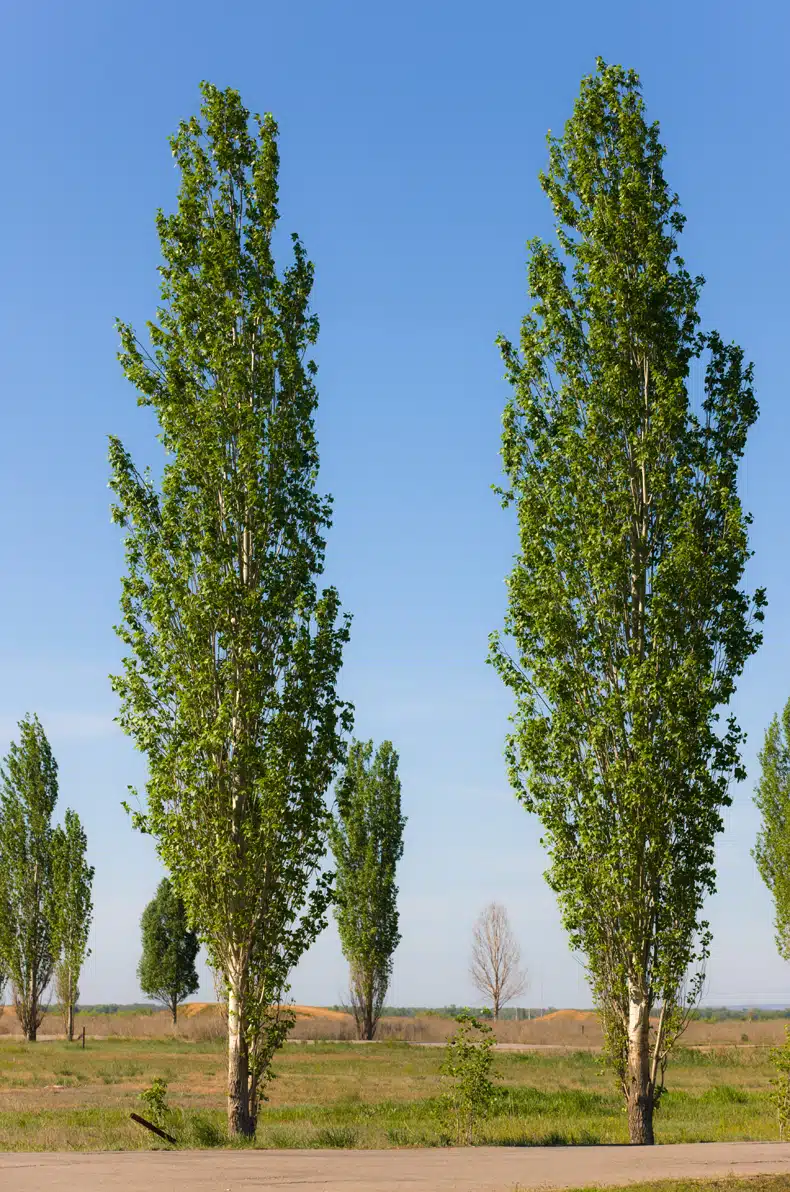
They have gray bark and grow clusters of flowers called catkins in the springtime. Some of the most common of this species include the balsam poplar, white poplar, and black poplar.
33. Horse Chestnut Trees
Horse chestnuts are large deciduous trees that can grow to huge heights. They can live for over 300 years and have a large, well-rounded crown that provides shade.
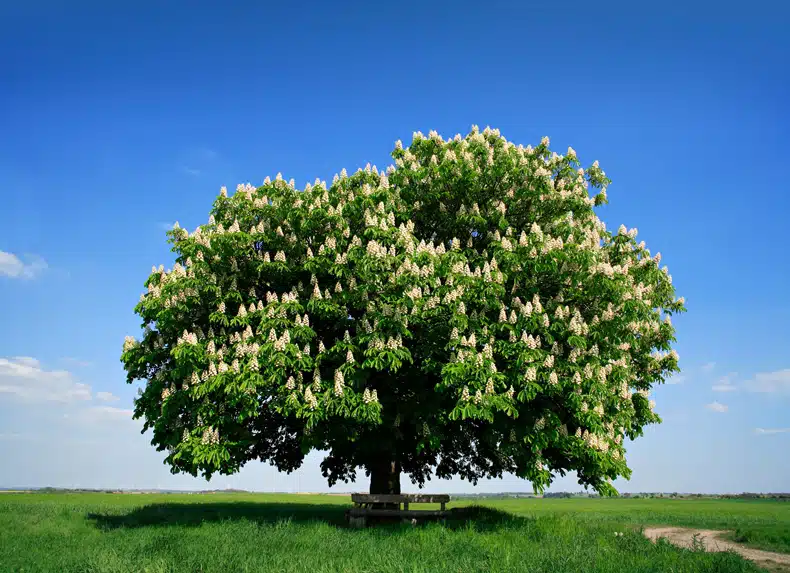
A horse chestnut is recognized by its distinctive round leaves and great height. Plus, you’re sure to notice the shiny round conkers inside their spiky green cases. These grow throughout the year and fall when ripe in the autumn months.
34. Larch Trees
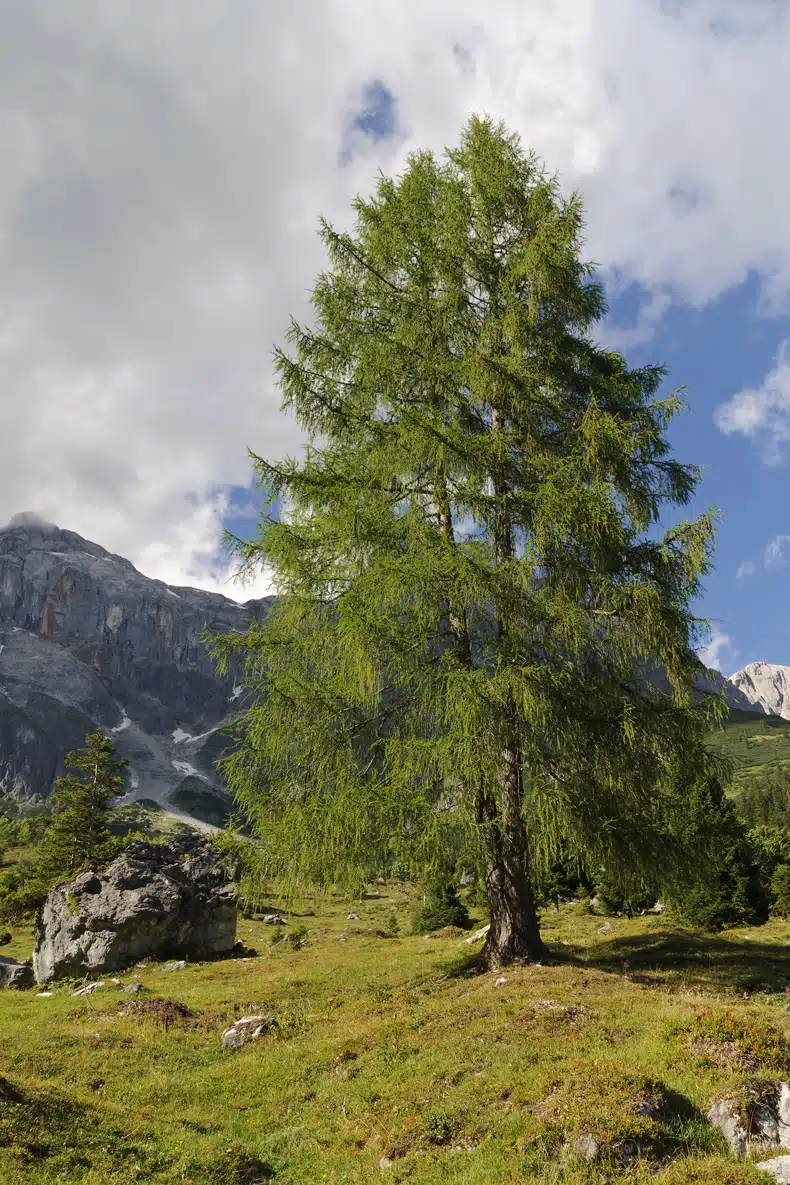
These cone-shaped deciduous trees are easy to spot. They grow flat needles that are soft rather than pointy. But unlike most conifers, they lose their needles in the winter. So, they stand out against other evergreen coniferous varieties. Common varieties include the European larch, the western larch, and the alpine larch.
35. Palm Trees
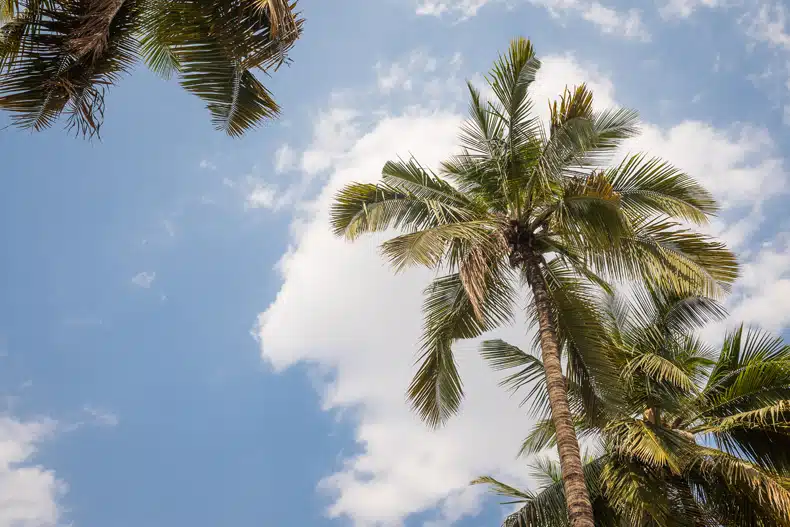
A very different tree, the palm tree grows in hot, tropical areas. They can be found in tropical regions of the Americas, Asia, Australia, and Africa. There are different types of palm trees, including the date palm, coconut palm, and oil palm. But in fact, there are more than 2,600 different varieties of palm trees.
36. Linden Trees
Linden trees have distinctive leaves that look like hearts. They bloom with pale yellow flowers in the spring. They also look spectacular in the autumn months when the leaves turn yellow.
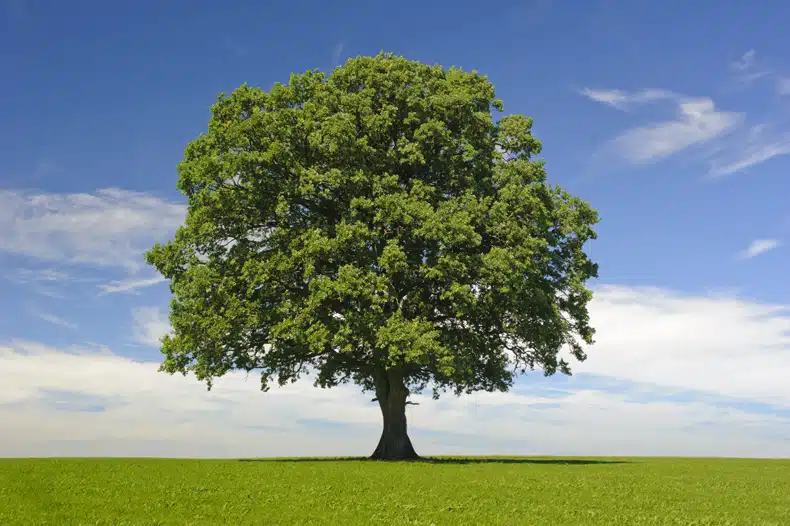
These trees can grow from medium to large, ranging from 70 to 130 feet. They have a large well-rounded crown of branches and leaves.
37. Acacia Trees
Acacia trees are endemic in Australia and some parts of Africa. They also grow well in certain states in the southern USA, where they get plenty of sun.
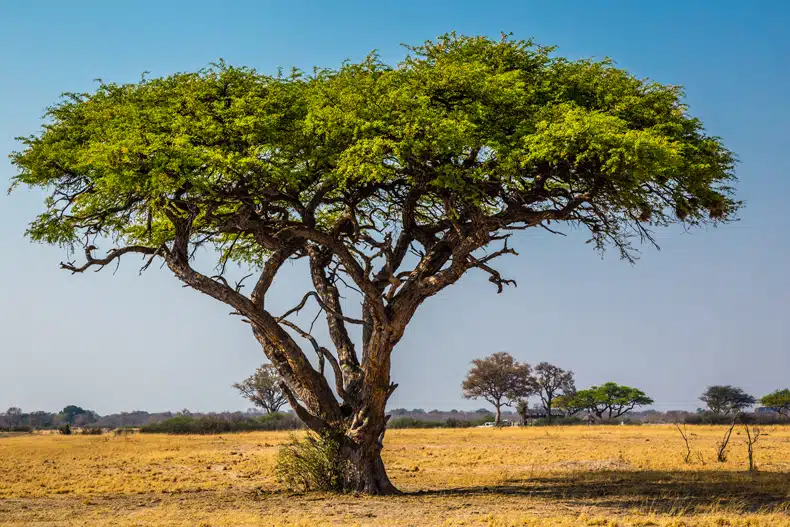
These trees grow fast and need very little maintenance. They’re used to warm climates, so they don’t need much rainfall to survive.
38. Sumac Trees
Compared to some of these large trees, the sumac can look tiny in contrast. Sumacs tend to be smaller trees or shrubs, reaching 30 feet at their highest.
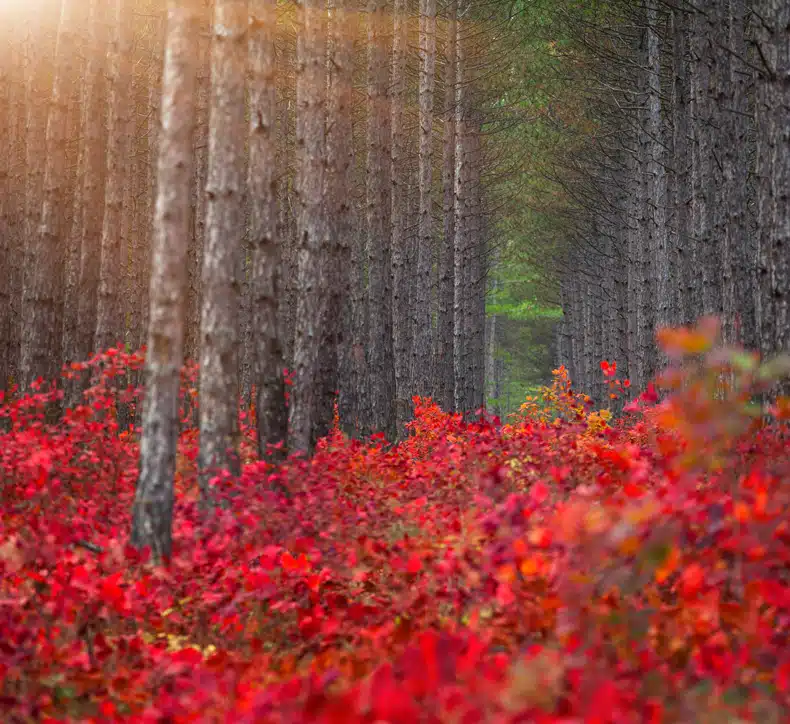
Depending on the time of year, you can identify a sumac by its white berries and clusters of red berries. The leaves also transform into gorgeous autumnal reds and purples in the fall.
39. Mulberry Trees
Mulberry trees are popular and grow across the world in temperate zones. They produce small berries that can be black, red, or white. Mulberries were used to treat ailments in traditional medicine in the past.
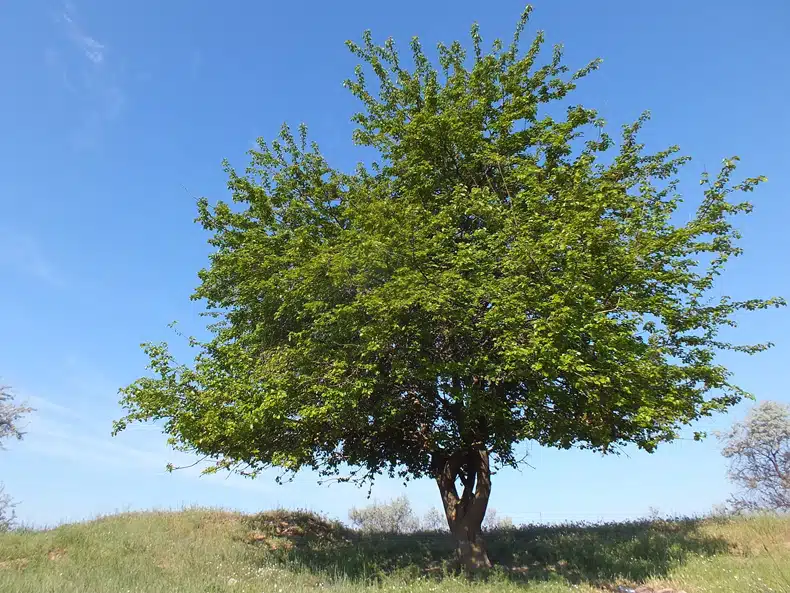
Mulberry trees are fast-growing, but they don’t tend to bear fruit for around ten years.
40. River Red Gum Trees
This tree is native to Australia and doesn’t grow anywhere else in the world. These trees thrive in areas prone to flooding and often grow near rivers or ponds. It’s an evergreen flowering tree that comes under the umbrella of the eucalyptus family.
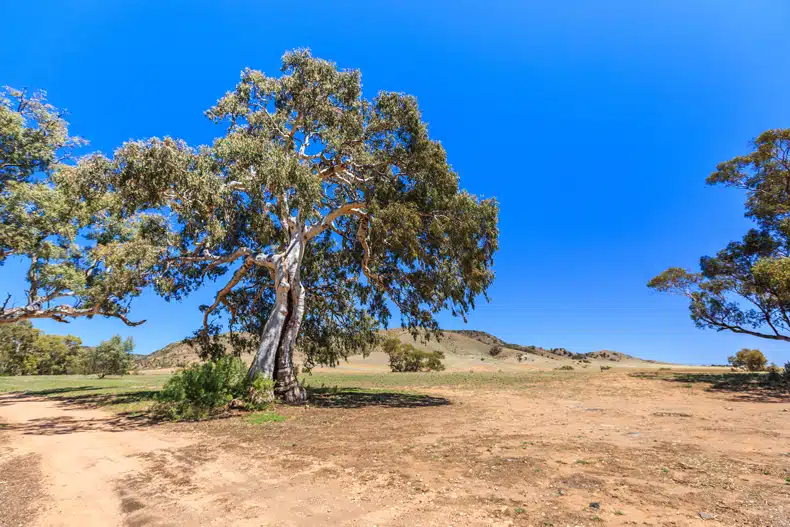
Furniture makers prize the river red gum tree for its sturdy red wood. And in their natural environment, many creatures find their homes in these trees. That includes many types of birds as well as bats and snakes.
41. Hemlock Trees
Hemlock trees are evergreens from the pine family that grow across North America. These trees are often very tall, reaching more than 200 feet.
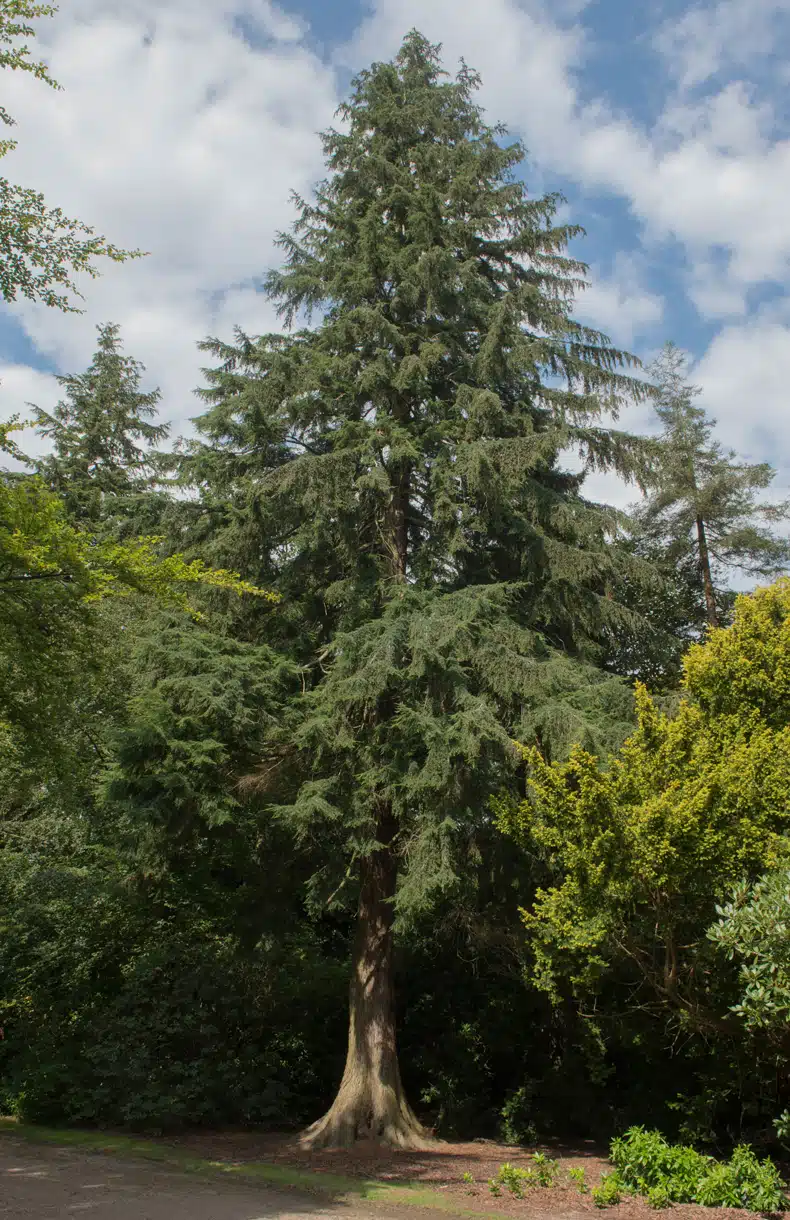
The distinctive conical shape of hemlock trees makes them easy to identify. They also grow lots of small cones and have long, soft needles. The bark is a reddish-brown color.
42. Redwood Trees
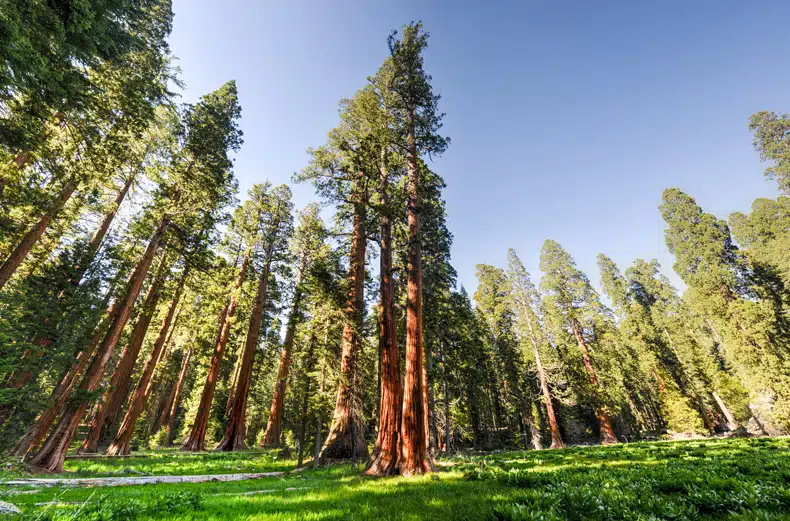
Redwood trees hardly need any introduction as they’re such an iconic species. They’re the tallest trees in the world and can grow to more than 300 feet. These giant trees have slim trunks and rich red bark. This large tree species thrives in areas with plenty of rainfall and humidity.
43. Monkey Puzzle Trees
The monkey puzzle tree is a unique species that’s very easy to identify. It looks bizarre but attractive in a quirky way. These trees originally come from the mountainous regions of Chile and Argentina.
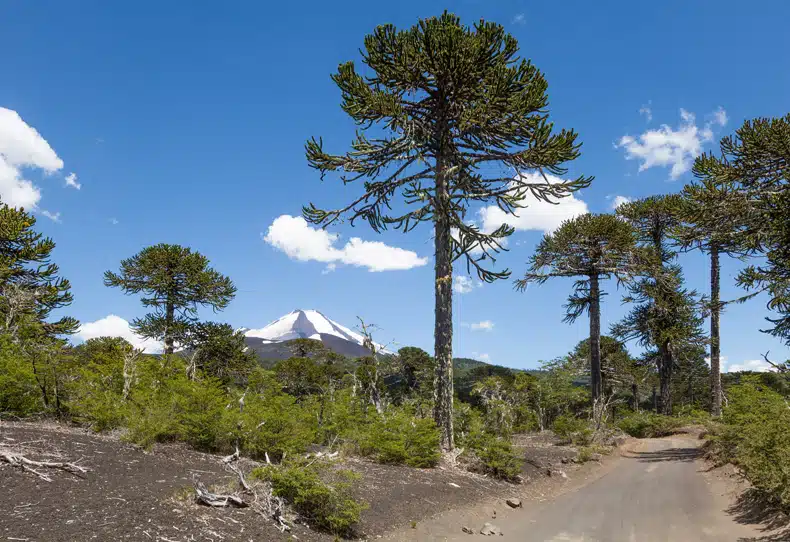
But they’ve since been exported around the world. If you’d like to see one, you can find them in botanic gardens all over Europe and North America.
The monkey puzzle’s leaves are spiky and scaly. They spiral out along the trunk and the branches of this evergreen tree.
44. Peppermint Trees
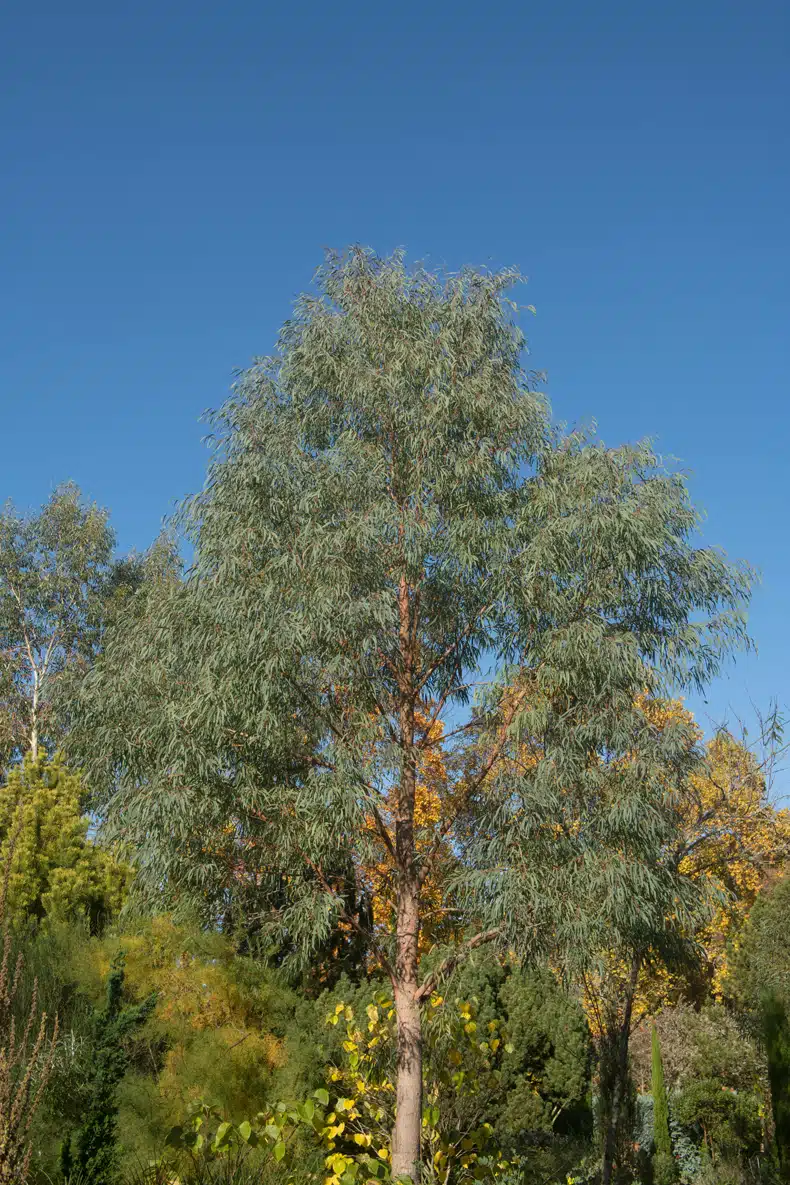
Despite the name, this tree doesn’t produce peppermint, which is actually a herb. But its flowers smell very like peppermint, hence the name. These native Australian trees have many other names, such as the willow myrtle. And in fact, they look quite similar to willow trees as the long leaves droop downward.
45. Kumquat Trees
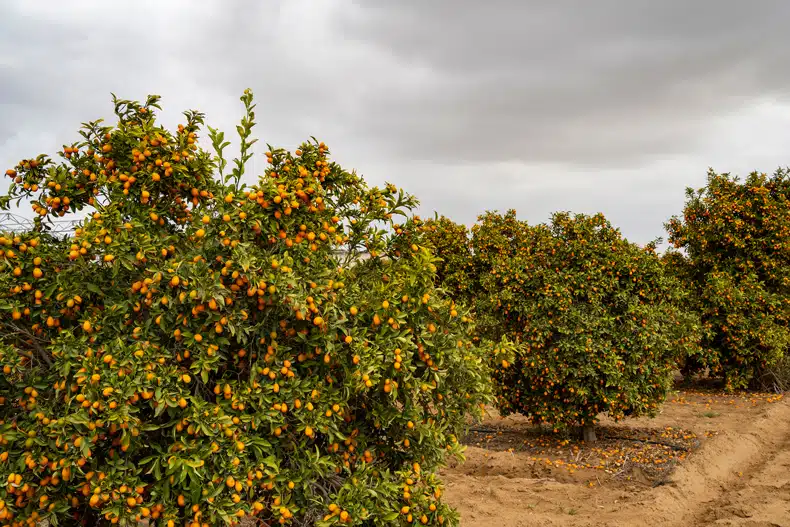
Kumquat trees are hardy trees that can survive cool temperatures. They’re of the citrus family and grow across much of Asia. But although they can withstand the cold, they need hot summers to produce their fruit. These trees are small with thick, glossy leaves and may have thorny branches. They bloom with white flowers, and in the summer, they carry dense crops of kumquats.
46. Lemon Trees
The lemon tree is an evergreen flowering tree of the citrus family. It grows natively in India, Myanmar, and China. But you’ll also find it in many other countries around the world, although it grows best in tropical regions. In fact, there are more than thirty different types of lemon trees.
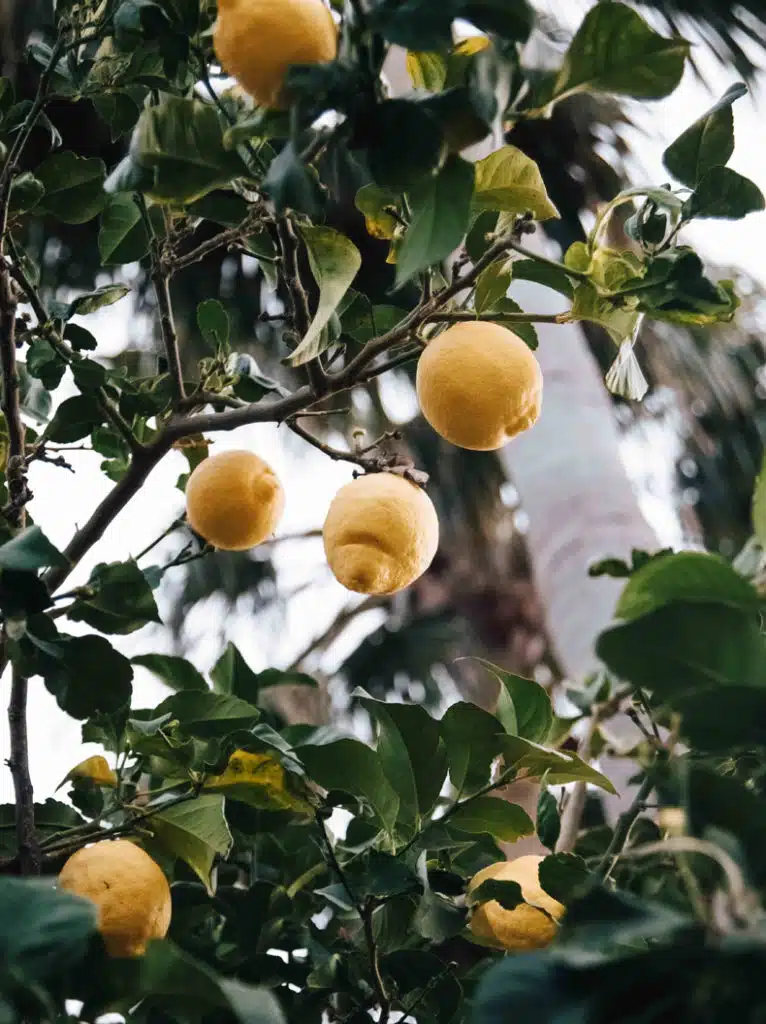
The lemon tree reaches around 10 to 20 feet in height and has small oval leaves. It may have thorny branches and produces lemons after around 5-6 years.
47. Orange Trees
The orange tree is another relatively small citrus variety. It grows to around 20 to 30 feet and doesn’t need much maintenance.
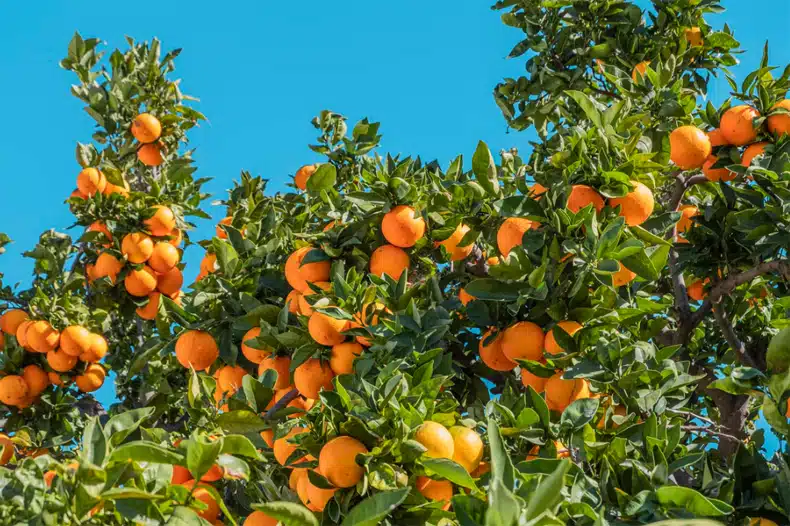
However, you’ll find that it grows best in warm climates. They can’t survive extended periods below freezing temperature.
It produces beautiful, delicate flowers in the summer with a strong, heady scent. Its crop of oranges is ready later in the year, often in the late autumn or winter months.
48. Argan Trees
Argan trees are endemic to Morocco and can survive arid climates. But due to this, these trees grow slowly and don’t reach great heights.
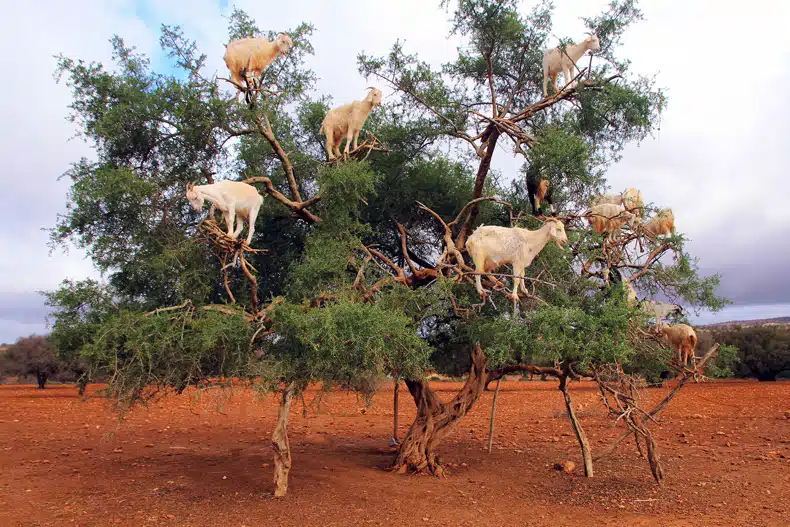
The argan tree has thorny branches to deter animals from eating the argan nuts it produces. These nuts are used to create argan oil for cooking and cosmetic use. And the pulp around the nut is useful for feeding livestock, so nothing is wasted.
49. Olive Trees
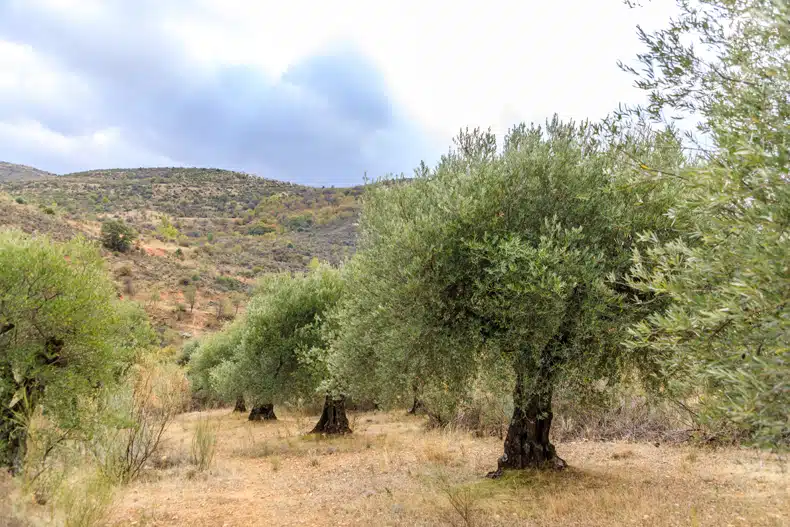
The olive tree is often considered a Mediterranean tree. But it also grows in many other places, including Australia, Mexico, and China. It’s one of the oldest trees in existence and can live for thousands of years. These trees grow slowly and produce a crop of olives each year when healthy. They’re essential for providing olives and olive oil for many cuisines.
50. Holly Trees
Last but not least on my list is the holly tree. They vary from small, bushy shrubs to large trees that grow up to 80 feet. These plants are evergreen and often have more than one main stem.
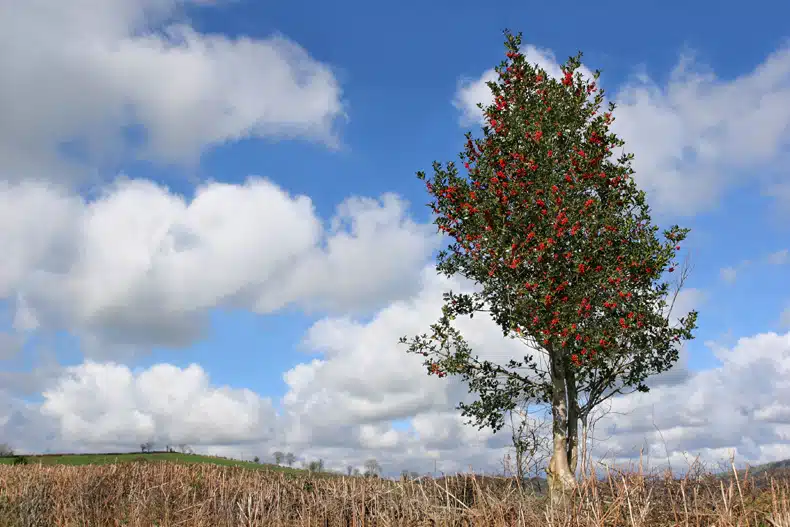
The holly tree is easy to recognize from its thick, shiny, spiky leaves. It produces rich red berries in the winter that look pretty but are toxic to humans. Sprigs of holly are sometimes used as Christmas decorations.
Tree Types FAQ
What are the most common trees?
The most common trees in the world are red alders, although pine trees are close behind. In the USA, the most common trees are the red maple, loblolly pine, and the American sweetgum. And in Europe, it’s the Norwegian spruce, silver fir, beech, oak, and ash trees.
What is the smallest tree in the world?
The smallest tree in the world is the dwarf willow which grows to only 2.3 inches in total. It grows in subarctic and arctic climes. Its small sizer helps it to survive in these harsh regions.
Final Thoughts
Now, you should be an expert on the most common types of trees. From winter trees names to mountain plants and trees names, we’ve covered so many varieties.
These pictures of trees with names will help you feel confident identifying trees. And you also know the distinctive features of these trees. So, you should be able to spot some of these trees when you’re out and about.


